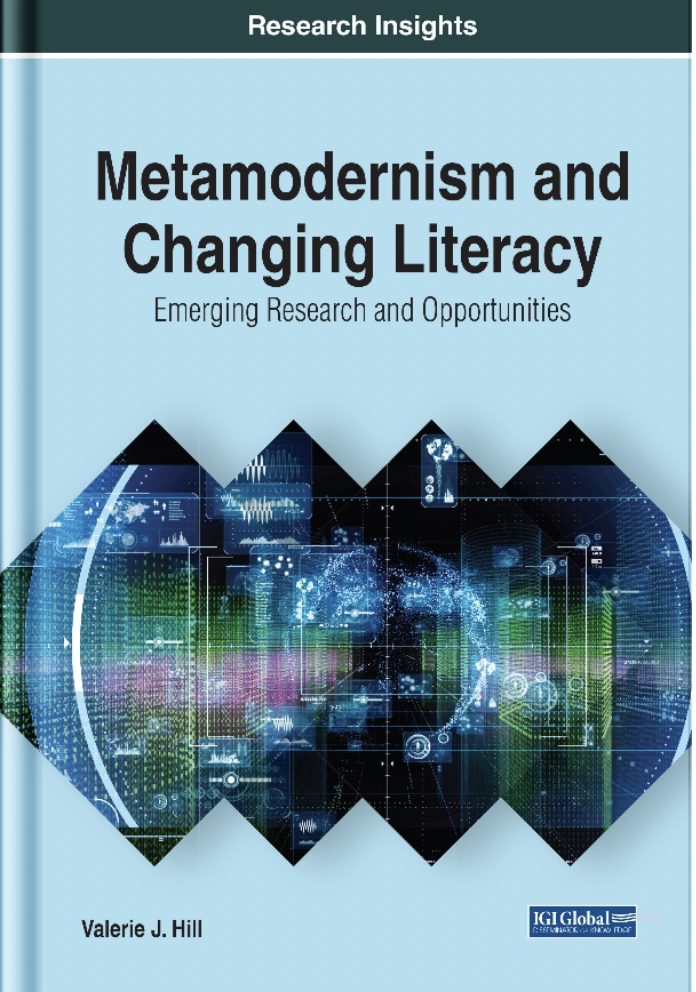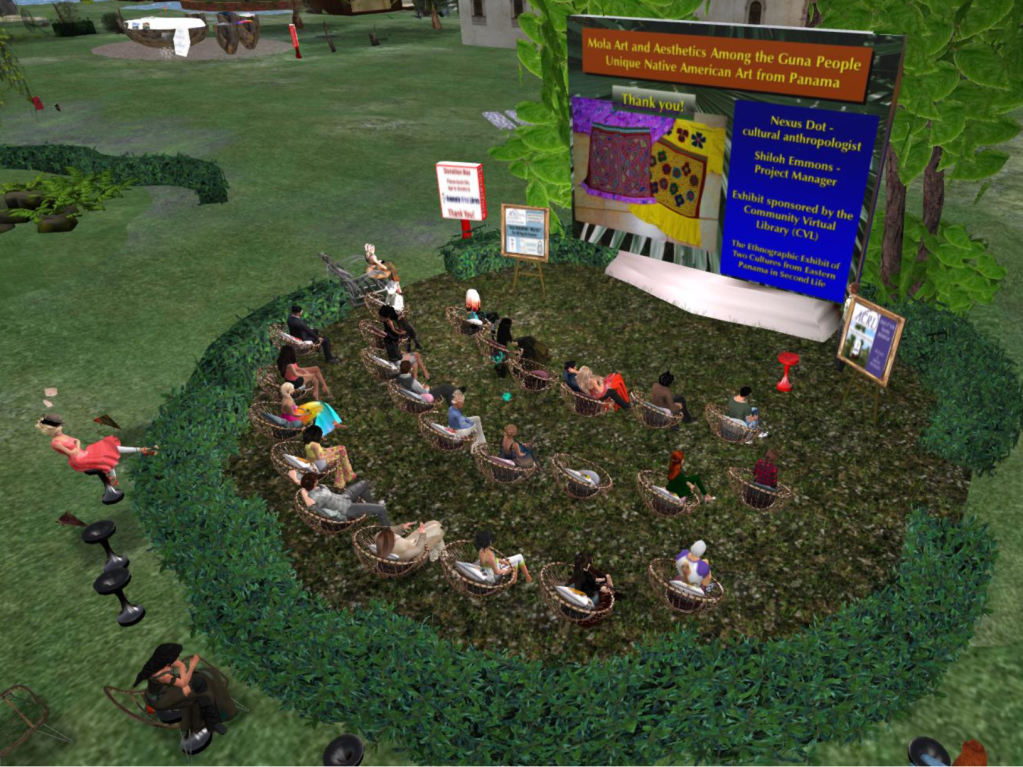This guest blog post is by Dr. Valerie Hill, Director of the Community Virtual Library (a library in virtual learning environments) and researcher of changing literacy in digital culture. Valerie believes metaliteracy aligns well to our philosophical era which many are beginning to call “metamodernism”.

Her recent book, Metamodernism and Changing Literacy: Emerging Research and Opportunities, focuses on metaliteracy for all age groups through an exploration of our metamodern moment. In the Foreword to this book, Thomas Mackey states, “Hill provides a fascinating exploration of metamodernism through the perspective of metaliteracy. This intersection between both theories is vital to our understanding of the relationship between digital culture and literacy.”
Certainly, over the past few months instructors and learners have been challenged by the need to plunge into virtual learning environments (like it or not!) due to Covid 19. Many educators have scrambled to learn new tech tools connecting to students through ZOOM and other apps. Obviously, lecturing online through a web camera has obstacles and limitations as there is little chance for interactive hands-on learning without a “shared space”. Entering virtual platforms for learning requires metaliteracy and the ability to reflect on information in multiple formats as we participate in digital spaces both consuming and producing information. We are surrounded by evidence that metaliteracy is essential, realizing that literacy is no longer defined as the ability to read and write. Options for online learning continue to evolve and a look at our philosophical era in relation to literacy helps us understand how deep learning can occur today and in the future.
The End of Postmodernism
Metaliteracy, as defined by Mackey and Jacobson (2014), is a term developed to better understand the need for digital citizens to reflect on their own literacy in globally networked culture through four domains: behavioral, cognitive, affective, and metacognitive. The ongoing process of learning through these domains takes place again and again over time. This need for metaliteracy was a perfect match to the changing era of postmodernism and the rise of networked culture; however, it is even more critical as we move beyond postmodernism. Several new concepts are emerging, such as: post-postmodernism, post-millennialism, trans-postmodernism, and the term used in this writing, metamodernism.
One of the hallmarks of postmodernism was deconstructionism and the tearing down of grand narratives and established belief systems. Postmodernism emphasized irony, engendered an abundance of dystopian literary works, and promoted a sense of the “death of history”. Metamodernism, in contrast, allows room for hope. Vermeulen and van den Akker (2010, p. 2) suggest, “History, it seems, is moving rapidly beyond its all too hastily proclaimed end.” Understanding changes in literacy may be better understood by exploring metamodernism and embracing metaliteracy.
Metaliteracy in Virtual Spaces
Literacy, we all know, has been revolutionized by digital culture bringing opportunities to access, create and curate content through a plethora of apps and digital platforms. Rapidly expanding digital tools have disrupted education, leading to the need for new nomenclature and a new look at literacy. As information landscapes continue to evolve, metaliteracy addresses goals and learning objectives for digital citizens which include 1) Evaluation of content and bias; 2) Advocating respect for intellectual property; 3) Producing and sharing through collaboration; and 4) Adapting to change through lifelong personal and professional goals.
While innovative learning spaces can be new and exciting, the metamodern individual seeks a balance of innovation with respect for history and tradition. Much can be gained by studying the past and reflecting on the learning journey of those who lived before us. These oscillations between the past and the present, between the physical and the virtual (or digital), and between numerous opposing concepts (the concrete and the abstract) surround us in our metamodern world and impact literacy as we juggle and swing between them in our minds. This juggling between modes of literacy and thinking influences our behavior, our knowledge and understanding, our feelings toward information, and our reflection on how we learn (notice the four domains of metaliteracy).
Choosing the best learning environment is challenging for educators and for learners as online classroom management platforms compete to provide educational applications and virtual spaces (even VR headsets) continue to rapidly expand. Many online spaces offer little interaction beyond observation through a webcam or interactive chat. Evaluating the criteria necessary for specific learning objectives is critical and a shared sense of place and presence can be of tremendous value.
3D virtual environments may play a greater role in simulating a shared learning experience using avatars, a simulated space across distance with the ability to learn in collaboration in a persistent environment (a space that remains over time rather than a one-time disposable experience). Research has documented the potential for high quality educational simulations for over fifteen years. Virtual worlds, such as Second Life or Kitely, offer learners tools to build alone or in collaboration with others. These virtual learning spaces require metaliteracy as users employ various new skills such as embedding online media, coding and scripting, using voice or text, collaborative building, applying the laws of physics, or back channeling through other platforms to communicate.

Great potential for learning and creating in virtual environments is evident; yet, so too is the need for a balance between the virtual world and the physical world. Metamodernism calls for a balance of both worlds and an appreciation of both. The process of becoming metaliterate is lifelong and the metamodern individual must be aware of the personal responsibilities we each hold as digital citizens. As XR (Extended Reality), VR (Virtual Reality), AR (Augmented Reality) and MR (Mixed Reality) continue to evolve, metaliteracy will become essential to education and daily life. Certainly, the unprecedented shutdowns caused by Covid 19 have brought a new appreciation of our physical world and our social interactions. A deep appreciation for the physical world alongside multiple “realities” is a metamodern concept.
Metaliteracy for all Age Groups in Digital Culture
From infancy through old age, we are all called upon to become digital citizens in today’s globally connected culture. Tiny tots see digital devices around them from birth and elderly people are often expected to utilize digital modes of communication from email and online shopping to texting and social media. Much of our online interaction takes place through social media and networked communities. “Metaliteracy promotes critical thinking and collaboration in a digital age, providing a comprehensive framework to effectively participate in social media and online communities” (Mackey and Jacobson, 2011, p. 62).
Becoming metaliterate is a process that begins at birth with the modeling of literacy (print books preferred for infants and toddlers!) imperative to development. Parents, children, educators, students, and lifelong learners are challenged to develop a personal awareness of metaliteracy and to “apply metaliterate learning as a lifelong value and practice” (Metaliteracy Goal 4:9) (Jacobson, et. al., 2019).
References
Hill, V. J. (2020). Metamodernism and Changing Literacy: Emerging Research and Opportunities. Hershey, PA: IGI Global.
Jacobson, T., Mackey, T., O’Brien, K., Forte, M. & O’Keefe, E. (2018). “Goals and learning objectives”. Metaliteracy.org. Retrieved from https://metaliteracy.org/learning-objectives/2018-metaliteracy-goals-and-learning-objectives/
Mackey, T. & Jacobson, T. (2014). Metaliteracy: Reinventing information literacy to empower learners. Chicago: ALA Neal-Schuman.
Mackey, T., & Jacobson, T. (2011). Reframing information literacy as a metaliteracy. C&RL, 72, 62-78.
Vermeulen, T. & Van den Akker, R. (2010). Notes on metamodernism. Journal of Aesthetics & Culture, 2, 1-14.

Pingback: Digital Citizens need Metaliteracy – Valibrarian
Pingback: Class 9: Digital Citizenship | Virtual Environments: Is one life enough?